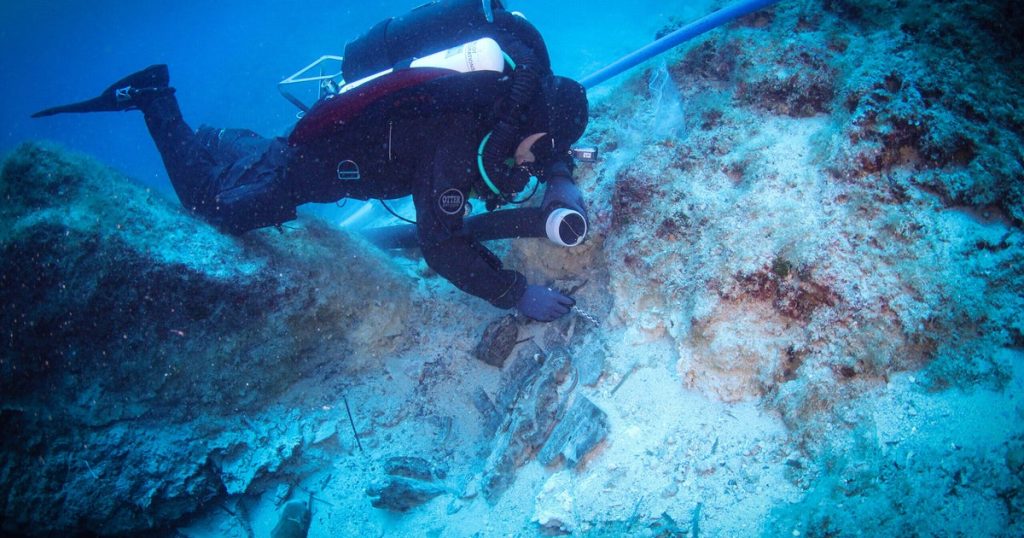An underwater expedition has yielded remarkable artifacts from the Antikythera shipwreck, shedding light on ancient maritime life and techniques. Conducted by the Swiss School of Archaeology in Greece, the mission took place between May and June 2025, allowing divers to excavate key structural elements of the ship dating back to the first century. Notable finds include wooden planks that illuminate the ship’s construction methods, alongside various artifacts that offer insights into the life aboard the vessel.
| Article Subheadings |
|---|
| 1) Discovery and Historical Context of the Wreck |
| 2) Recent Excavation Efforts and Techniques |
| 3) Key Artifacts Unearthed |
| 4) The Challenges of Underwater Exploration |
| 5) Importance of Findings to Archaeology |
Discovery and Historical Context of the Wreck
The Antikythera shipwreck, discovered in 1900 near the Greek island of Crete, dates back to the first century BCE. This remarkable wreck is often considered one of the most significant underwater archaeological sites, revealing insights into ancient maritime practices and life. Historical records and archaeological studies suggest that the vessel was a trading or cargo ship, used for transporting goods across the Mediterranean.
Initial explorations of the wreck have uncovered intriguing artifacts, including life-sized marble statues, ancient jewelry, and hundreds of works of art. Human remains were also found during excavations in the 1970s, indicating the tragic circumstances surrounding the ship’s demise. The recent findings provide further connections to the lifestyle and craftsmanship of the people of that era, reflecting a rich history that has intrigued researchers and historians alike.
Recent Excavation Efforts and Techniques
The latest expedition, conducted by the Swiss School of Archaeology in Greece, occurred over a six-week period from May to June 2025. The primary goal was to recover three outer planks that had been previously identified but left in situ until this dive. These planks provide a rare opportunity to study the ship’s internal structure and construction techniques.
These recovery efforts were carefully planned, with divers utilizing modern closed-circuit rebreathers to manage their respiratory gas efficiently at depths of 140 to 170 feet. This depth presents unique challenges, being too deep for standard scuba diving yet not deep enough for the use of remotely operated vehicles. Dive teams were supported by underwater drones, which provided real-time surveillance of the excavation, enhancing both safety and efficiency.
Key Artifacts Unearthed
Among the many significant discoveries from the recent dive were small fragments of a nude male statue, a terracotta mortar, and numerous Chian amphorae, jars used in ancient Greek times for storage and transport. The statue pieces offer insights into the artistry of the period, as does the terracotta mortar, which highlights the culinary practices of ancient civilizations.
The wooden planks retrieved are particularly noteworthy, as initial analyses suggest they might be comprised of elm and oak. These materials are believed to date back as far as 235 BCE. The unique construction method indicated by these hull fragments reveals that the construction techniques employed ranged from the fourth to the first century BCE, further deepening our understanding of ancient naval architecture.
The Challenges of Underwater Exploration
Exploring the Antikythera wreck necessitates navigating a host of challenges due to its depth and the surrounding environment. The divers must contend with strong currents, low visibility, and the physical demands associated with deep-sea diving. These difficulties highlight the need for advanced technologies and strategies to ensure the safety and success of archaeological missions.
In addition to monitoring divers’ activities, the underwater drones also assist in documenting the excavation process, capturing visual data that can be analyzed post-expedition. This integration of technology enhances the capability to explore deep-sea sites like Antikythera, enabling researchers to make the most of each dive.
Importance of Findings to Archaeology
The recent discoveries from the Antikythera wreck provide invaluable contributions to the field of archaeology by enhancing our understanding of ancient trade networks, construction methodologies, and daily life in the past. The artifacts recovered serve as tangible connections to ancient societies, illuminating their craftsmanship, and cultural practices.
As research continues, these findings might reshape contemporary perspectives on ancient maritime practices, contributing to broader discussions on the interconnectedness of historical civilizations. The results of the excavation not only further archaeological knowledge but also foster a greater appreciation for the rich tapestry of human history.
| No. | Key Points |
|---|---|
| 1 | The Antikythera shipwreck dates back to the first century BCE and is located near Crete. |
| 2 | Recent excavations were conducted by the Swiss School of Archaeology, focusing on recovering key wooden planks from the ship. |
| 3 | Significant artifacts, including a nude male statue fragment and terracotta mortar, were retrieved during the dive. |
| 4 | Explorers faced considerable challenges due to the wreck’s deep location, necessitating advanced diving techniques. |
| 5 | The findings enhance our understanding of ancient naval strategies and trade networks. |
Summary
The recent exploration of the Antikythera shipwreck has not only unveiled remarkable artifacts but also provided invaluable insights into the construction and operation of ancient maritime vessels. The meticulous recovery efforts and the advanced technologies employed highlight the ongoing commitment to preserving and understanding our historical heritage. As research progresses, the findings will likely reshape our understanding of ancient civilizations and their complex trade networks.
Frequently Asked Questions
Question: What is the significance of the Antikythera shipwreck?
The Antikythera shipwreck is significant because it provides a glimpse into ancient maritime practices, trade networks, and the craftsmanship of the period, revealing vital details about life in antiquity.
Question: What artifacts have been discovered from the shipwreck?
Artifacts from the shipwreck include life-size marble statues, jewelry, terracotta mortars, and various amphorae, which highlight the ship’s commercial activities and cultural context.
Question: What challenges do divers face while exploring the wreck?
Divers face challenges such as strong underwater currents, low visibility, and the demands of diving at depths that require advanced techniques, including the use of closed-circuit rebreathers.


